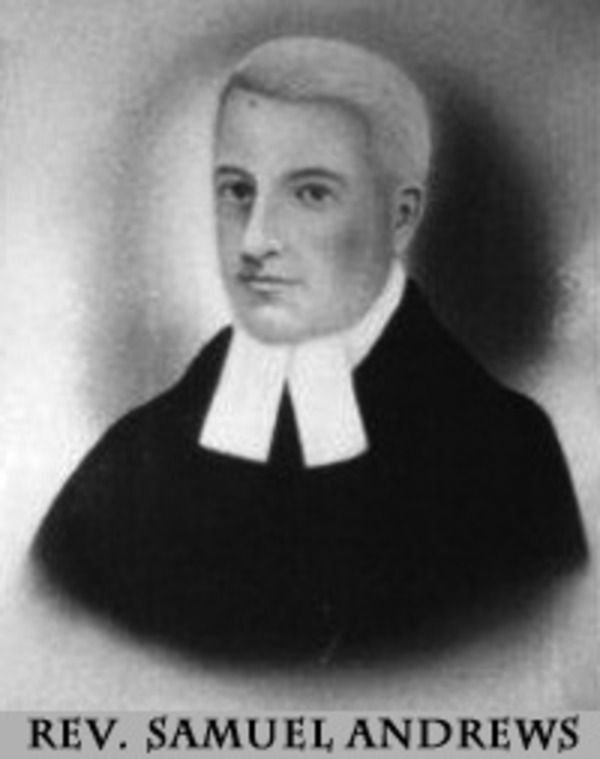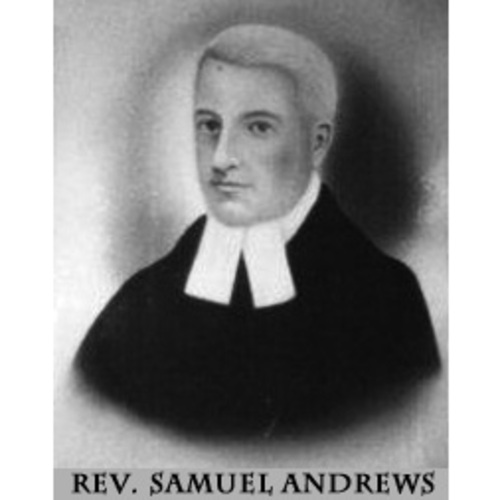
Source: Link
ANDREWS, SAMUEL, Church of England clergyman; b. 27 April 1737 in Wallingford Township, Conn., youngest son of Samuel Andrews and Abigail Tyler; m. 13 Sept. 1764 Hannah Ann Shelton of Stratford Township, Conn., and they had six children; d. 26 Sept. 1818 in St Andrews, N.B.
When he was a young boy, Samuel Andrews’s family left the Congregational Church and joined the Church of England. It was the time of the Great Awakening and young Samuel grew up in the midst of a clamorous ecclesiastical atmosphere. He graduated from Yale College in 1759, spent two years as a lay reader in Wallingford, and was chosen by his fellow churchmen as a candidate for holy orders.
In April 1761 Andrews proceeded to England with John Beardsley. They were ordained deacons on 23 August and priests on 24 August by the archbishop of Canterbury, Thomas Secker, in Lambeth Palace chapel. Appointed a missionary of the Society for the Propagation of the Gospel to serve the Wallingford area, Andrews took up his charge in January 1762 and proved to be an untiring worker. His conscientious reports to the SPG show a steady growth in church membership while recounting the difficulties in ministering to widely scattered congregations, some of them far outside his own mission. At the time of the Stamp Act crisis in 1765 Andrews reported that under “the peculiar Circumstances of the Times” he had been preaching on the “Duty of Obedience to the higher Powers,” a stand taken by most of his fellow Anglican clergy. Although his lack of sympathy with those opposing the Stamp Act marked him as a tory, his work was undisturbed until the actual outbreak of hostilities.
In June 1775 Andrews had occasion to exhibit his loyalist sympathies. At a town dinner in George Washington’s honour, the guests suffered through a long-winded, patriotic opening prayer. When called on to give thanks after dinner, Andrews simply quoted Eccles. 5:21, “Be not rash with thy mouth, and let not thine heart be hasty to utter any thing before God: for God is in heaven, and thou upon earth: therefore let thy words be few.” He then sat down, having displayed not only his political stripes but a well-honed sense of humour as well.
On 20 July 1775, a day prescribed by the Continental Congress for prayer and fasting, Andrews’s most overt action against the rebellion took place. Choosing as his text Amos 5:21, “I hate, I despise your feast days . . . ,” he gave a sermon in which he again spoke against resistance to authority, calling on Americans to do nothing “but what the laws of God approve” in order to serve their country. His remarks aroused much hostility, and in response Andrews published them to show that he was not in contempt of the fast day but was prompted by a concern for his countrymen. He was nevertheless placed under heavy bonds to keep the peace and severely restricted in his movements; only the high regard for him in the town saved him from physical violence. During the war years he ministered as best he could, but undoubtedly suffered indignities and distress. Upon renewing his correspondence with the SPG in 1782, after a lapse of six years, he was reluctant to describe “my own Concerns, since the Troubles,” reporting instead on the work he had performed in that time.
After the war Andrews and his friend James Scovil, rector of Waterbury, travelled to Nova Scotia in 1784 as agents for parishioners wishing to settle there. A promise of land in the Chedabucto Bay area was obtained from Governor John Parr*, but the scheme fell through for lack of aid with moving costs and supplies. When the SPG was obliged to withdraw its support of missionaries in the United States it offered several positions in New Brunswick to its Connecticut clergy. In August 1785 Andrews advised the SPG that he would continue in its service, but it was not an easy decision. Despite his wish to enjoy British government, his first concern was for his parishioners, which “would prevail against every Consideration, did I not conceive that the Penury to which I and my Family must soon be reduced, would prevent the Success of my Labours.”
On 25 May 1786 Andrews arrived at Saint John and received his appointment from Lieutenant Governor Thomas Carleton to serve the shiretown of St Andrews and the whole of Charlotte County. It was a rugged coastal and inland area just being settled, but at St Andrews itself the new rector found a well-ordered populace “of different National extractions.” He set to work without delay organizing his mission, and then in October 1786 returned to Wallingford to settle his affairs and to fetch his family. While there he suffered a paralytic stroke and after a partial recovery arrived back in St Andrews on 14 July 1787. A second attack in November severely curtailed his ability to travel, but by the end of 1788 he had recovered sufficiently to resume his rounds.
Andrews’s ministry in Charlotte County involved extensive and arduous travel by sea as well as land to reach remote settlements. His reports recount a continuous tale of service, illness, and financial hardship as he worked to counter “straggling New Lights,” “fanatic teachers from the American States,” and “ignorant Anabaptist Teachers” who “infested” the extremities of his mission from time to time. Despite repeated requests he did not obtain an assistant until just before his death, but his persistent efforts led to the appointment in 1811 of Richard Samuel Clarke as SPG missionary in St Stephen (St Stephen-Milltown).
During his years in New Brunswick Andrews maintained contact with old Connecticut friends, among them Abraham Jarvis, the second bishop of Connecticut. Andrews had played a full role in the struggle to establish an episcopate in the American colonies during his ministry there, and he espoused a similiar cause while in New Brunswick. Along with most of the loyalist clergy, however, he did not favour the choice of Charles Inglis as bishop of Nova Scotia in 1787. Eventually Inglis’s neglect of New Brunswick brought forth requests for a separate diocese, and Andrews and his fellow clergy urged Carleton to press for a bishop resident in the province.
Along with his religious orthodoxy Andrews possessed a liberal outlook and a fine sense of humour which were able to win and retain the affections of the large nonconformist element in St Andrews. The persistent exertions of the preacher Duncan M’Coll* to establish Methodism on a firm footing in St Andrews met with little success, and during his lifetime Andrews was able to maintain the town’s allegiance to the Church of England. Only after his death did the various denominations set up their own churches, and for a decade after his death Methodism remained “a foreign element” in the town. Andrews’s service in St Andrews can truly be said to have “represented a triumph for the Church of England in that parish.”
Although he had no commercial interests, Andrews gathered regularly with the town’s leading merchants in the Friendly Society, which he founded in 1803. At its convivial gatherings members discussed science, philosophy, and other learned matters. These meetings and his printed sermons, which are superior in style and matter to many of those published by his contemporaries, show Andrews to have been a man of broad intellectual interests.
In 1791 Andrews purchased an island near St Andrews on which he lived the rest of his life, riding across the tidal bar to and from his duties. Now called Ministers Island, it commemorates his former presence in the area. At his death Andrews was widely mourned on both sides of the border. This “venerable and Pious and Primitive Missionary” performed a masterly job in organizing the church in his large pioneer mission despite frequent bouts of ill health. His diligent efforts, and those of the other loyalist clergy who worked long and hard to serve the needs of their parishioners, firmly settled the Church of England in New Brunswick.
[Eleven of Samuel Andrews’s sermons are known to have been printed. C. K. Shipton and J. E. Mooney, National index of American imprints through 1800 . . . (2v., Worcester, Mass., 1969), lists seven dating from 1769 to 1787. Dexter, infra, gives three others, two printed together in 1801 and one from 1809. The last known to be published, dated 1811 on the occasion of Andrews’s 50th anniversary as a priest, is to be found in USPG, C/CAN/NB, 1, no.8. The sermon of 20 July 1775 that so aroused local sentiment against Andrews was published as A discourse, shewing the necessity of joining internal repentance, with the external profession of it; delivered upon the general fast, July 20th, 1775 (New Haven, Conn., 1775). A portrait of Andrews is reproduced in Acadiensis (Saint John, N.B.), 3 (1903): facing p.197; the location of the original is not known. j.l.w.]
PANB, MC 58, “Bishop Inglis letters, 1787–1842,” comp. W. O. Raymond (copies); RG 7, RS63, 1818, Samuel Andrews. USPG, B, 6, no.226 (transcript at PAC); 23, nos.4–22, 24–25; C/Am, 3, nos.37–38, 57–60; C/CAN/NB, 1, no.1a (mfm. at PAC); Journal of SPG, 15, 25–31 (mfm. at PAC). The Church of England in pre-revolutionary Connecticut: new documents and letters concerning the loyalist clergy and the plight of their surviving church, ed. K. W. Cameron (Hartford, Conn., 1976). F. B. Dexter, Biographical sketches of the graduates of Yale College, with annals of the college history (6v., New York and New Haven, 1885–1912). J. S. Andrews, Samuel George Andrews and family ([Rochester, N.Y.?], 1919). A. M. Baldwin, The clergy of Connecticut in revolutionary days (New Haven, 1936). E. E. Beardsley, The history of the Episcopal Church in Connecticut, from the settlement of the colony to the death of Bishop Seabury (2v., New York and Boston, 1866). R. M. Calhoon, The loyalists in revolutionary America, 1760–1781 (New York, 1973). A. W. [H.] Eaton, The Church of England in Nova Scotia and the tory clergy of the revolution (New York, 1891). An historic record and pictorial description of the town of Meriden, Connecticut, and men who have made it . . . , comp. C. B. Gillespie and G. M. Curtis (Meriden, 1906). H. G. Kinloch, “Anglican clergy in Connecticut, 1701–1785”
Revisions based on:
Clergy of the Church of Eng. Database Project, “Andrews, Samuel (1761–1761)”: theclergydatabase.org.uk (consulted 27 April 2020).
Cite This Article
John L. Williamson, “ANDREWS, SAMUEL,” in Dictionary of Canadian Biography, vol. 5, University of Toronto/Université Laval, 2003–, accessed April 2, 2025, https://www.biographi.ca/en/bio/andrews_samuel_5E.html.
The citation above shows the format for footnotes and endnotes according to the Chicago manual of style (16th edition). Information to be used in other citation formats:
| Permalink: | https://www.biographi.ca/en/bio/andrews_samuel_5E.html |
| Author of Article: | John L. Williamson |
| Title of Article: | ANDREWS, SAMUEL |
| Publication Name: | Dictionary of Canadian Biography, vol. 5 |
| Publisher: | University of Toronto/Université Laval |
| Year of publication: | 1983 |
| Year of revision: | 2020 |
| Access Date: | April 2, 2025 |



